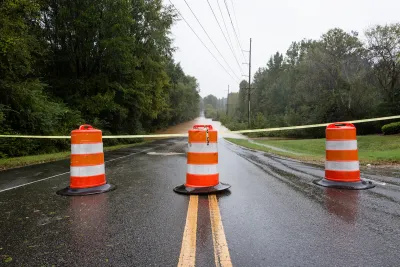The tool will allow local planners to evaluate impacts of flooding and prioritize projects with the biggest return on investment.

The tool will allow local planners to evaluate impacts of flooding and prioritize projects with the biggest return on investment.
The North Carolina Department of Environmental Quality (DEQ) is developing a new online tool to help inform future flood planning. The “Flood Resiliency Blueprint” will compile research and data about flooding in the state to provide a framework that local officials can use to guide adaptation and mitigation efforts, says a Governing article by Adam Wagner.
In the face of more frequent, intensifying rain events, the goal is to help local governments more easily identify projects that will have measurable outcomes for their communities so they can take swift action. “Officials will be able to home in on the area where the project is proposed and see exactly how many people, homes, roads and community assets the project will protect,” Wagner writes.
The tool is designed so anyone can use it and will use two-dimensional modeling that allows planners to evaluate the impacts of flooding from rivers and heavy rain events. “To make sure we know what the projects with the best return on investment are, we are developing a standardized methodology to analyze flood risk and prioritize flood mitigation strategies across the state. We are ensuring that decision makers at all levels will be able to identify and select which strategies are most impactful where they are,” DEQ Secretary Elizabeth Biser told Governing.
The North Carolina legislature allocated a total of $20 million for the project, which includes developing and building the flood blueprint tool, as well as six river basin-specific action strategies. Another $96 million has been allocated to fund the construction of projects identified in those river-basin planning documents.
Some state legislators expressed concerns that the blueprint would be used by DEQ to tell local governments which actions they can and cannot take. Biser assured them that, apart from how the $96 million is spent, the state will not be the decision-making entity on local projects.
Beta testing for the tool is slated for mid-April and launch is expected in December.
FULL STORY: North Carolina Is Spending Millions on a Flood Blueprint

Analysis: Cybertruck Fatality Rate Far Exceeds That of Ford Pinto
The Tesla Cybertruck was recalled seven times last year.

National Parks Layoffs Will Cause Communities to Lose Billions
Thousands of essential park workers were laid off this week, just before the busy spring break season.

Retro-silient?: America’s First “Eco-burb,” The Woodlands Turns 50
A master-planned community north of Houston offers lessons on green infrastructure and resilient design, but falls short of its founder’s lofty affordability and walkability goals.

Test News Post 1
This is a summary

Analysis: Cybertruck Fatality Rate Far Exceeds That of Ford Pinto
The Tesla Cybertruck was recalled seven times last year.

Test News Headline 46
Test for the image on the front page.
Urban Design for Planners 1: Software Tools
This six-course series explores essential urban design concepts using open source software and equips planners with the tools they need to participate fully in the urban design process.
Planning for Universal Design
Learn the tools for implementing Universal Design in planning regulations.
EMC Planning Group, Inc.
Planetizen
Planetizen
Mpact (formerly Rail~Volution)
Great Falls Development Authority, Inc.
HUDs Office of Policy Development and Research
NYU Wagner Graduate School of Public Service




























